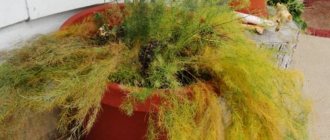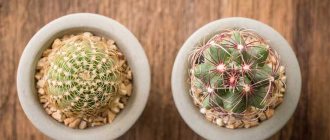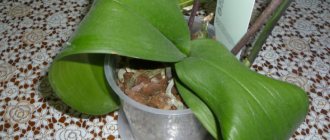What kind of water to water indoor flowers?
Many novice gardeners use tap water to water their indoor flowers. It's not so bad, but it contains chlorine and lime, which plants don't like at all. High chlorine levels in tap water can cause shoot tip dieback and leaf scorch.
To avoid this, pour water into the watering can in advance. Let it sit for at least a day - during this time it will warm up to room temperature, settle, and the chlorine will evaporate from it.
After watering with settled water, whitish spots may appear on the surface of the soil and on the leaves. To soften tap water and avoid the formation of plaque, you can add lemon juice or a few grains of citric acid to it. You can also use vinegar (10 drops of table or apple cider vinegar per 1 liter of water), wood ash (3 g of ash per 1 liter of water) or a special lime neutralizer, which is sold in flower shops.
Carry out sanitary pruning
To make the flower recover faster, cut off some foliage. Feel free to get rid of old, limp and damaged greenery.
It does not bring any benefit, but it takes away strength and nutrients that the plant could spend on restoring a healthy part. If there are no wilted greens, remove a few of the lower leaves.
How often to water indoor plants in winter
One of the most common mistakes made by indoor floriculture enthusiasts is unregulated watering. In the warm season it is better to water the plants in the evening, and in the cold season - in the morning.
In autumn and winter, the frequency of watering should be minimized. I can’t recommend an exact time period, because the location of the plants and air humidity in each house are different. I advise you to focus on the condition of the soil: if it is loose (don’t forget to loosen the soil), then you can check the moisture with your finger, deepening it 2 cm. If there are no traces of soil left on your finger, you can water the plant.
You can also use a soil moisture meter - these are sold in flower departments. For me, this device is my number one assistant. When immersed in the ground, the sensor shows the degree of moisture: “dry”, “wet”, “too wet”.
If, when watering, water immediately pours out of the pot, almost without being absorbed into the soil, it means that the soil has dried out. You should saturate it with moisture - immerse the potted plant in a container of water up to the soil level.
Is it possible to place a flooded plant in the sun?
Some gardeners believe that by placing a flooded plant in a sunny window, you can quickly get rid of the problem. In fact, this cannot be done, since the roots flooded with water will simply dry out and the flower will die quite quickly.
If you did not replant the plant, but dried the soil using one of the methods described above, then the pot with it must be removed as far as possible from bright light. It is advisable that the temperature in the room where the pot is located is about 18-20 degrees Celsius. In this case, the appearance of strong drafts and sudden drops or increases in temperature is undesirable.
Most often, the plant is flooded in autumn or winter, since at this moment the period of vegetative dormancy begins, and the flower requires much less moisture. If you continue to water in the same way as in summer, you can harm the plant. Therefore, before watering, be sure to pay attention to the soil: it should be dry not only on the surface, but also 3-5 centimeters deep.
How to determine the lack or excess of moisture in a flower pot
With a lack of water , plants grow poorly, their leaves become drooping and withered, the edges of the lower leaves become brown and dry, the flowers quickly wither and fall off.
When there is excess water , the leaves fall off, signs of rot appear on them, the lower leaves turn yellow, their tips turn brown, the flowers may become moldy, and the roots may become soggy.
In addition, plants can be divided into groups according to the degree of soil moisture they require:
- excessive watering - there should be a lot of moisture in the soil. These are cyperus, calamus, adiantum, azalea;
- abundant watering - you need to constantly keep the soil moist, but the water should not stagnate. Most ornamental plants belong to this group. For example, alocasia, begonia, heliotrope, calathea, lemon, oleander, ivy need such watering;
- moderate watering - before the next watering, you need to let the top layer of soil (about 2 cm) dry out a little. These are aglaonema, aspidistra, dracaena, clivia, columna, monstera, palm trees, syngonium;
- infrequent watering - the soil must be kept dry, and the plant must be watered only during the growth period. These are hippeastrum, gloxinia, zygocactus, caladium, crinum, epiphyllum, philodendron, cacti, succulents.
My history
I also had problems with the bay in the past.
My lack of experience did not allow me to understand why suddenly the leaves of my begonia hung lifelessly and began to look limp.
I thought that the plant did not have enough water, I watered it again and again. As a result, I confess, I hopelessly flooded the flower and it died. Only later did I find out that when there is excess moisture, leaf turgor is lost and I found information about what this is connected with.
With experience came the ability to recognize plant signals. I have sifted through a lot of literature and now I can share my experience on how not to overwater an indoor flower, but to give it exactly as much moisture as it needs.
What to do if the flower is flooded?
A common situation: “While I was on vacation, I entrusted flowers to my husband. He poured the monstera. So what's now?"
Urgently replant the plant: remove it from the pot onto previously spread newspapers, blot it thoroughly, let the roots dry, shake off the old, wet soil and place it in a pot with a large drainage hole and new drainage.
If the plant has already begun to turn yellow and the trunk has become soft, it means that the roots have begun to rot. To save the plant, it also needs to be transplanted into new soil, but before that you need to inspect the roots: rotten ones should be cut off.
If there is nothing left to save - there are no living roots - then you can cut a living trunk and try to root it (it is advisable to do this not in water, but in a peat tablet, but it depends on the plant). This way you will still have this look.
Care after eliminating the consequences and preventing recurrence of the problem
It is easier to prevent flooding than to treat the plant for it later. For prevention, you just need to follow the basic rules of care:
- Properly water according to one of the above schemes.
- Feed on time, phosphorus and potassium fertilizers are especially important.
But it is better not to use nitrogen-containing substances. This will lead to a lack of flowering and a set of excess leaf mass. Remember that after overwatering, the plant especially needs additional feeding to recover.
One of the most common problems when growing orchids is flooding. Fortunately, the plant can be saved and watered properly in the future. You should not forget to feed the orchid vigorously after overwatering so that it recovers faster.
What air humidity should be maintained in an apartment where there are indoor flowers?
For tropical plants, the optimal air humidity is 85-95% in summer and 70-80% in winter, for subtropics in pots - 60-70%, queen orchids need to create a humidity of 50-80%.
My house usually has 50% humidity in the summer and 20% in the winter (with central heating). This is not enough. This is why the leaves of indoor flowers dry out.
I offer you simple ways to humidify the air:
- open containers with water;
- wet towels on heating radiators (in winter);
- wet pebbles in the tray;
- sphagnum moss in pots;
- water sprayers.
Humidifiers have always been and remain the ideal option. Steam humidifiers have proven themselves better than ultrasonic ones. Steam humidifiers are used in many indoor plant nurseries.
By the way, plants are perhaps the best air humidifiers after aquariums and home ponds. Therefore, if you want to breathe clean, moist air, consider landscaping your home.
Be careful - autumn
The transition period in autumn can be especially dangerous. From the second half of September, the conditions for keeping flowers worsen. The cold comes to the apartments, because of the rains the air is oversaturated with moisture, the level of lighting decreases sharply. This is the most dangerous time when the likelihood of flooding the plant increases sharply.
We recommend: How to properly care for cupressus at home
During this period, you need to water the flowers very carefully. It will be possible to increase the frequency of watering after the heating is turned on. It would also be useful to organize additional lighting - this will make life easier for the plants.
Insect pests, diseases
Insect attacks and diseases can destroy both demanding crops and picky flowers.
Fungal diseases
Fungal diseases include:
- late blight;
- powdery mildew;
- gray rot;
- root rot;
- fusarium;
- rust;
- leaf spot;
- sooty fungus.
This is what fusarium looks like on Saintpaulia.
Fungicides are used to treat them. Regular ventilation of the room, moderate spraying that does not lead to dampness, watering with Fitosporin once a month are the main preventive measures.
Bacterial diseases
The most dangerous bacterial diseases of indoor pets:
- spotting;
- cancer;
- withering;
- rotten.
Weakened plants usually die, but if the rules of care are followed, plants can overcome the disease on their own. To prevent flowers from suffering from bacterial diseases, you need to:
- avoid overwatering and excessive spraying;
- do not overfeed your pets with nitrogenous fertilizers;
- before transplanting, disinfect the fresh substrate;
- Treat the pot with boiling water before planting.
Be sure to maintain a small distance between pots with different plants.
Insect pests
Any gardener knows about these insects. First of all this:
- spider mite;
- aphid;
- scale insect;
- thrips;
- mealybug;
- whiteflies.
In advanced cases, the spider mite entwines entire young shoots.
The mite belongs to the arachnids. To destroy it, specialized acaricides and broad-spectrum insecticides have been developed.
Finding other insects is not difficult. They are easy to see during a careful examination of the pet using a magnifying glass. Characteristic leaf lesions are also a good clue.
When thrips attack, affected areas are formed. Gradually they merge with each other. On the reverse side of the leaf you can see adult insects and their excrement
Question to the expert
What drug is best to use to kill thrips?
Typically, Aktelik, Aktara, Biotlin, Fitovers and a number of other drugs are used to exterminate pests. The advantages of Aktara are in a wide range of actions. In addition, its solution can be used to spill the soil in the pot of an infected plant. And this is very important. After all, adult insects lay their eggs in the substrate.
When destroying pests, you cannot stop at a single treatment. To eliminate the threat, you need to maintain the dosage and carry out 4 sprayings with an interval of 1 week.
Loosening after watering is a necessity
You've probably seen a set of tools for indoor plants on sale. Did you buy it? Or are you just getting ready? There is one incredibly useful item there - small rakes. However, they can easily be replaced by an ordinary kitchen fork; that’s what I use.
After watering, the soil must be loosened. What do we achieve in this case:
- Destroy the dense top crust.
- As a result, the roots are provided with the oxygen flow necessary for their normal functioning.
- Moisture evaporates freely from the earthen clod without accumulating in the root zone.
- Even an overwatered flower dries out faster in this case.
I carry out loosening 3-4 hours after watering, when the soil no longer sticks together into lumps and easily gives in to a fork or rake. This procedure takes a little time, but its importance cannot be overestimated.











